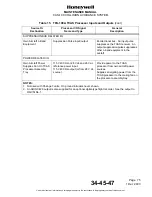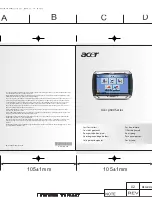
Page 58
1 Dec 2003
34-45-4
7
MAINTENANCE MANUAL
CAS-100 COLLISION AVOIDANCE SYSTEM
Use or disclosure of information on this page is subject to the restrictions in the proprietary notice of this document.
•
Supplies the following data to the TPA-100A TCAS Processor through a ARINC 429
data link:
-- Own aircraft identification code, pressure altitude, and maximum airspeed data.
-- TCAS broadcast data and air-to-air resolution advisory coordination data received from
other TCAS equipped aircraft.
-- TCAS sensitivity level and other mode control data received by own Mode S transponder
from own transponder/TCAS control unit.
-- TCAS sensitivity level control data from Mode S ground control stations at 1030 MHz
(future application).
-- Mode S ARINC 604 Maintenance status.
•
Receives TCAS capability, TCAS validity, sensitivity level, and TCAS coordination
update data from the TCAS processor through the ARINC 429 data link and inserts
this data into 1090 MHz coordination messages.
H. CTA-100( ) Control Unit
The CTA-100( ) Control Units are examined in this manual to a depth necessary to know total
TCAS operation. For more data, refer to TRA-67 Mode S Transponder System Maintenance
Manual, I.B. 1167.
The microprocessor based CTA-100( ) Control Unit lets the pilot do the following:
•
Start or stop the Mode S transponder.
•
Select TCAS operating modes, control range, above/below altitude limits, and flight
level compared to related altitude displays on the TCAS traffic display unit.
•
Set the ATC transponder identification code.
•
Insert a special pattern identifier code (IDENT) into transponder messages to ground
station interrogations.
•
Start TCAS functional test.
•
Set which transponder is in operation in a two transponder system.
•
Set the altitude source (optional).
•
The CTA-81( ) contains an annunciator lamp that shows if a transponder FAIL
condition is present.
















































